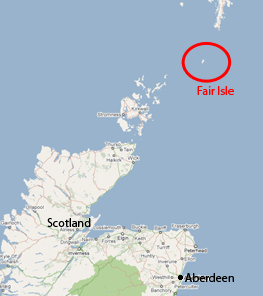
Fair Isle
Fair Isle is a small island in the northern parts of Scotland. It can be located about halfway between the Orkney and Shetland island groups and is considered to be one of the most remote inhabited islands in the UK. With a population of less than 100 it doesnít require much power, but electricity is needed nonetheless to provide these residents with a good quality of life.
The Problem
Due to its isolated location Fair Isle is not connected to a major electricity network. Prior to 1982 all electricity was obtained through two diesel generators which would power the island for about 2 hours every morning and from dusk to 11pm each day [ii]. The reason for the very limited electrification hours was basically down to the cost of diesel as an energy source. But with diesel prices steadily rising at around 1980 the Fair Isle Electricity Committee (later the Fair Isle Electricity Company Limited [i]) decided to start looking at alternative energy solutions [ii].
The Solution
With average annual wind speeds found to be about 9.95m/s wind is in abundance on the island making this an ideal choice of power generation. In 1982 Fair Isle built its first wind turbine; a 60kW generator which automatically starts when wind strength is sufficient. In 1996 a second wind turbine was built with a power rating of 100kW [i].
Itís important to ensure the running of the turbines is as easy and safe as possible. Being a remote island manpower and resources are relatively limited so itís best to avoid complicated systems and build in the hope of low maintenance and danger. Wind speeds on Fair Isle can in fact reach past 40m/s which would cause the turbines to spin at dangerous speeds. To avoid this stall-regulated blades are used on the turbines. These are designed in a way in which they will combat wind speed by reducing the winds angle of attack on the blade. This reduces efficiency and so regulates the turbines rotational speed to within safe levels [ii]. With automatic start up too when a sufficient wind blows Fair Isle is much better supplied than it ever used to be running on diesel alone [i].
Today, the system is set up using two networks. One, a higher priority services network and the other a heating network. The heating network is used to take on any electricity that would otherwise be dumped due to overproduction. If there is not enough power being generated then the heating network will remain offline and all generated power is supplied to the services network.
Wind turbines today supply at least two thirds of the islands energy needs [iii]. There are several ways of operation. Depending on if wind strength is enough a single turbine may be sufficient to supply the island. If there are light winds and the single wind turbine canít generate enough on its own a diesel generator may be called in to add support. Another operating mode is to bring the two wind turbines in synchronous operation. This lets them run together and share the islands load in proportion to energy capture. If both wind turbines enter failure because of slow winds then the diesel generators will be called in. As previously mentioned the heating load is always regarded second to the service load and it is in these cases where wind speeds are low that we would find the services network supplied only [i].
The inhabitants of Fair Isle would have grown accustomed to having electricity as a resource back when they had just diesel generation. However, it was so limited to them that it likely would have not been able to improve their standard of living a whole deal, especially in relation to the rest of the UK. Thus with the implementation of two wind turbines the residents are provided with a much more available and cheaper source of electricity to power their homes and keep them better connected to the outside world.
[i] Fair Isle. Fair Isle Renewed. [Online] Available from:
www.fairisle.org.uk/FIECo/renewed/introduction.htm [Accessed 17/11/2010]. References
[ii] Somerville WM. Operating experience of the Fair Isle wind turbine. Physical Science,
Measurement and Instrumentation, Management and Education - Reviews, IEE Proceedings A 1987;134(5): pp. 413-426.
[iii] Wikipedia. Fair Isle. [Online] Available from:
http://en.wikipedia.org/wiki/Fair_Isle [Accessed 17/11/2010].



